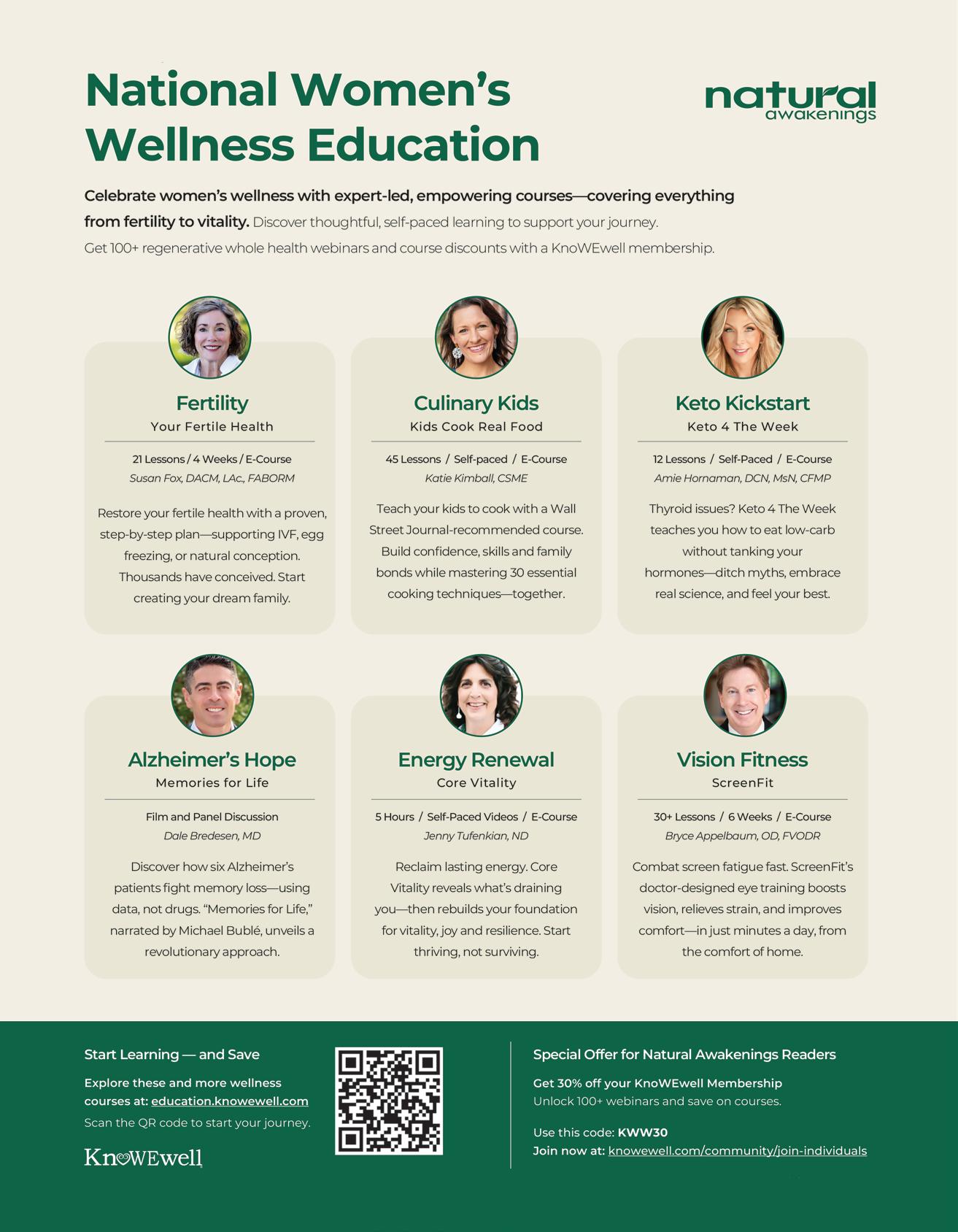





Scents of Unity: Perfumes That Embrace Our Shared Humanity
Scents of Unity: Perfumes That Onenessly Embrace Our Shared Humanity
Customer Testimonial:
The first time I smelled this perfume, it was love at first scent. The scent is unique, fragrant and long lasting. As a person who has sensitivity toward certain brands of makeup and perfume, I am very careful what products I use. I have used this perfume for quite some time now and I have never had any allergic reaction to it. This perfume is produced with the finest ingredients, and the person who wears it will stand out in a good way. I am a loyal customer, and I will continue to use this amazing perfume. — Carol C.


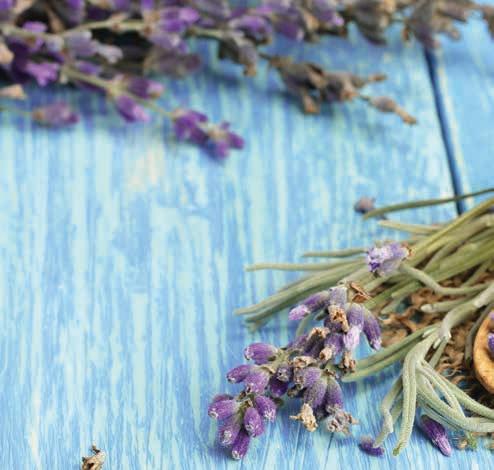






PLANET
Welcome to this month’s issue, where we explore the interconnected aspects of personal wellness and environmental responsibility. True wellness encompasses both personal care and environmental stewardship.

In our feature story, Women in Bloom: Balancing Hormones for Optimal WellBeing (page 16), we delve into the natural hormonal transitions women experience throughout life. From puberty to postmenopause, these shifts can bring various physical, mental, and emotional challenges. Medical professionals offer valuable insights on how lifestyle choices, medical support, and emotional care can help women navigate these transitions with confidence, recognize signs of imbalance, and embrace this journey with resilience.
Hair health concerns affect countless women, often stemming from genetics, stress, hormonal fluctuations, or nutritional deficiencies. Our comprehensive review of natural solutions for female pattern hair loss (page 14) examines both internal and topical remedies, from promising nutraceuticals like Nutrafol to natural treatments such as rosemary oil and hemp-based formulas. With expert guidance from dermatologists and wellness professionals, you’ll discover actionable strategies to support healthy hair regrowth and optimal scalp care.
Environmental consciousness extends to our fitness routines as well. In our Green Living department’s Sustainable

Sportswear: Banishing
Plastic From Fitness Apparel (page 24), the author investigates how highperformance activewear, while comfortable and durable, often releases harmful microplastics into waterways and ecosystems. Learn about the environmental impact of synthetic sportswear, discover emerging eco-friendly alternatives, and find practical tips for reducing microfiber shedding at home.
Speaking of environmental impact, our Eco Tip article (page 12) offers a practical guide to composting food scraps and yard waste. Whether you’re interested in a backyard pile, an indoor composter, or community programs, this article covers the essentials for reducing landfill waste while producing nutrient-rich soil. You’ll find setup tips and tool recommendations to seamlessly incorporate composting into your daily kitchen routine.
As we journey together toward greater wellness and environmental responsibility, remember that each choice we make— whether for our bodies or our planet— creates ripples of positive change.
“The greatest wealth is health. The greatest gift is our ability to make choices that honor both ourselves and the earth that sustains us.” – Hippocrates


Susan Q Wood Publisher
Natural Awakenings
3900 Galt Ocean Dr #1403 Fort Lauderdale, Florida 33308 NaturalAwakeningsFla@gmail.com 561-626-5584
Publisher Susan Q Wood
Editor Cheryl Hynes
Design & Production Robin White Contributing
National & Local Accounting NA Palm Beach Distribution M&M Media Distribution
Yearly subscriptions are available, $39 for 12 monthly issues.
Natural Awakenings Magazine is ranked 5th Nationally in CISION’S® 2016 Top 10 Health & Fitness Magazines
CEO Kimberly B. Whittle
COO Michael Bevilacqua
CMO Vee Banionis
Sr. VP Operations Brian Stenzler, DC
National Editor Sandra Yeyati
Editor Brooke Goode
Copy Editor Melanie Rankin
Print Production Specialist Kevin Rankin
Design Director Agnes Mazeikaite
Production Flip180
Executive Admin Julius Frago
Natural Awakenings Publishing Corporation 350 Main Street, Suite 9B
Bedminster, NJ 07921
Ph: 239-206-2000
NaturalAwakenings@KnoWEwell.com
Cover Image by: Adobe Stock
© 2025 by Natural Awakenings. All rights reserved. Although some parts of this publication may be reproduced and reprinted, we require that prior permission be obtained in writing.
Natural Awakenings is a free publication distributed locally and is supported by our advertisers. Please call 561-626-5584 to find a location near you or if you would like copies placed at your business. We do not necessarily endorse the views expressed in the articles and advertisements, nor are we responsible for the products and services advertised. Check with a healthcare professional regarding the appropriate use of any treatment.


Natural Awakenings is printed on recyclable newsprint.




Due date for advertising is the 10th of the month. ARTICLE BRIEFS & SPOTLIGHTS
Submit content for consideration: NaturalAwakeningsFLA@gmail.com. CALENDAR SUBMISSIONS Login/Join & Order Online: NAPalmBeach.com/calendar
Natural Awakenings Publishing Corporation (NAPC) has been serving local, regional, and national communities since 1994. Call 561-626-5584 for information. NAPC: For franchising opportunities call 239-206-2000 or email NaturalAwakenings@ KnoWEwell.com.


Oracle Oasis represents a fresh approach to psychic guidance, stripping away mystery and superstition to focus on intuition development. The organization helps clients trust their inner wisdom and gain the confidence to create
their desired lives. They operate on the principle that intuition is an innate gift accessible to everyone—a divine tool that can be cultivated for clearer life navigation and decision-making.
Their readings provide a grounded, enjoyable experience founded on the belief that all individuals can harness their intuitive abilities to shape their reality. Oracle Oasis views intuition as a universal connection that allows people to check their life trajectory and actively create their future. A core part of their mission involves educating clients about the various ways Spirit communicates and teaching them to recognize these signs.
Services include comprehensive readings utilizing diverse divination tools such as oracle cards, pendulum, and tarot, alongside their signature Soul Intention Readings. These specialized readings reveal a person’s soul plan, intended achievements, and unique talents to help align them with their higher potential.
For more information or to schedule a session, contact Oracle Oasis at 561-316-9535 or Hello@OracleOasis.com. Visit OracleOasis.com today to discover upcoming events and begin your journey toward intuitive empowerment. See ad page 31.

Cherie Bender has been an artist all her life, starting from childhood. “I really think that it is the only occupation I am right for,” Bender states. Having exhibited her paintings and drawings in galleries and museums both internationally and locally, Bender still gets nervous when asked about techniques, mediums, and subject matter, explaining that she simply gets inspired with a vision and then draws it.
According to Bender, it is important to pay attention and catch these visions, while maintaining strong drawing skills. One of Bender’s mentors, Charles White, a famous illustrator, advised her to become very good at drawing, which became her primary focus. Painting, she notes, is the last step after perfecting the drawing.
Having graduated from the University of Miami and attended Art Center in California, Bender embarked immediately on a successful illustration and commissioned fine art career that continues to this day.
Pictured here, Bender relaxes during Christmastime at her Florida home with her Japanese puppies, in front of one of her oil paintings, Uber Femme [when I was sixteen], which was exhibited at the Boca Raton Museum. Currently, Bender is writing an illustrated cookbook titled Cherie Bender’s Glitter Book Of Magical Cooking, focusing on organic, nonGMO, free-range gourmet recipes, scheduled for release soon.
For more information about Cherie Bender’s work or upcoming cookbook, contact the artist directly at 561-789-1648 or visit her website at CherieBender.com to explore her portfolio and receive updates on her latest projects. See ad page 29.

Amy Elise, known professionally as The Raw Vegan Life Coach, is offering private health coaching services to West Palm Beach residents seeking to improve their overall wellbeing. With over 20 years of experience in the wellness field, Elise specializes in diet and lifestyle modifications designed to enhance physical, mental, and spiritual health.
A certified holistic health coach, wellness educator, detoxification specialist, yoga teacher, and Reiki practitioner, Elise provides both in-person sessions at her home office and remote consultations. Her signature program, “The Path To True Health,” follows a three-step approach aimed at comprehensive health transformation.
Interested individuals can schedule a complimentary 30-minute discovery call to learn more about her services. For additional information, contact Amy Elise at 561-616-9603, email Amy@TheRawVeganLifeCoach.com, or visit her website at TheRawVeganLifeCoach.com. See ad page 31.

The Florida State Massage Therapy Association (FSMTA) is hosting its annual Convention and Trade Show from June 27 to 30, in Orlando, Altamonte Springs.
The event features a bustling exhibit hall filled with the latest health and wellness products. Attendees can partake of more than 130 hours of continuing education from internationally renowned educators while taking advantage of special deals on items for their practices, fostering valuable business relationships and learning cuttingedge techniques from leaders in the massage therapy field.
A variety of registration options for the convention are offered, including full registration, single day, and exhibit hall only, as well as CPR/AED certification and tickets for the Ian McIntosh Legislative Dinner. FSMTA members receive discounted rates on registration and are encouraged to attend the FSMTA Annual Meeting Luncheon.
This event underscores FSMTA’s commitment to education, advocacy and networking within the massage therapy profession.
To join FSMTA, register for the convention and/or learn more, visit FSMTA.org. See ads page 9 and 23.
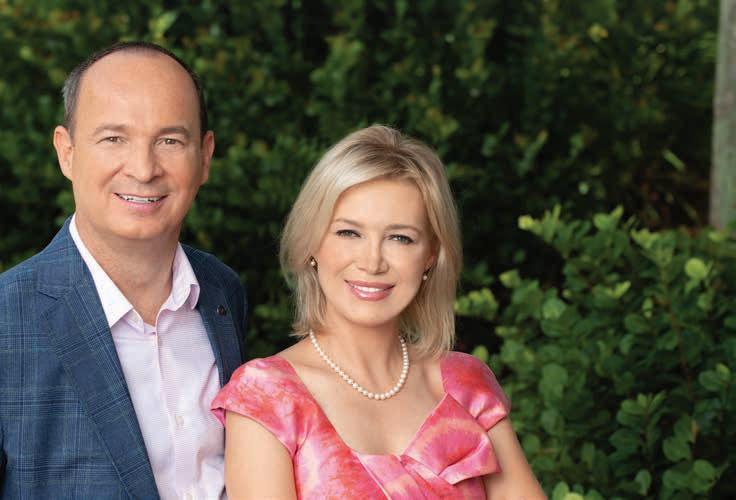
Dr. Ilona Fotek, DMD, MS: Concierge cosmetic dentist and certified naturopath specializing in holistic and biologic treatments. Focuses on restoring natural, youthful smiles for confidence and beauty.
Dr. Paul Fotek, DMD, MS: Double board-certified biologic periodontist at Prestige Periodontal and Implant Center. Expert in implant esthetics, practicing alternative approaches for accelerated healing and health. Together, they founded BioHealth Aesthetics & Wellness, offering personalized treatments for holistic health and aesthetics. Using advanced technology and concierge service, they help patients achieve comprehensive wellness goals.
It is our attitude at the beginning of a difficult task which, more than anything else, will affect its successful outcome.
— William James



















Dementia affects approximately 10 percent of Americans aged 65 and older. A study published in the journal Neurology suggests that processed red meats like hot dogs, sausage, salami, bologna and bacon may increase the risk of developing dementia. The eating habits of more than 133,000 participants without a dementia diagnosis at the start of the study were tracked for more than 40 years through surveys every two or four years.
According to the researchers, those consuming the greatest amount of processed red meat had a 13 percent higher chance of developing dementia compared to subjects in the low processed red meat group. (A serving was deemed to be three ounces, and high consumption was defined as one quarter of a serving or more daily, or roughly two servings per week.) The study also reported that those consuming the most processed red meat exhibited lower cognitive function and accelerated brain aging compared to people that consumed the least amount of processed red meat. Further research is needed to understand how diet may influence the onset of dementia.

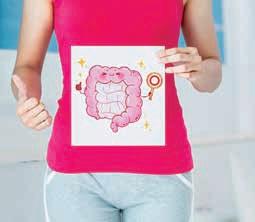
In a study published in the journal Cell Reports Medicine, researchers evaluated the frequency of weekly bowel movements and the overall health of 1,400 healthy adults. The participants were separated into four groups: constipated (one to two bowel movements per week), low-normal (three to six bowel movements per week), high-normal (one to three bowel movements per day) and diarrhea. The scientists also gathered information about the participants’ age, sex, genetics and gut microbiomes.
The study revealed that age, sex and body mass index (BMI) significantly influenced bowel movement frequency. Younger individuals, females and those with a low BMI tended to have less frequent bowel movements.
Individuals in the high-normal group—deemed by researchers to be optimal—had similar gut microbiomes that efficiently converted fiber into beneficial short-chain fatty acids. Those with less frequent bowel movements had gut microbes that consumed the available dietary fiber, leading to protein fermentation and the release of harmful toxins into the bloodstream. The researchers hypothesized that these toxins could be the link between bowel health, inflammation and an increased risk of chronic diseases.
Participants with constipation had higher levels of byproducts of protein fermentation in their blood, which is known to damage the kidneys. Those with diarrhea had blood plasma patterns associated with liver damage. The study underscores the importance of dietary and lifestyle choices, such as increasing the intake of fruits and vegetables, to normalize bowel movement frequency.


A girl should be two things: who and what she wants. — Coco Chanel
Researchers at the University of Pennsylvania have developed prototype teeth-cleaning devices that use microrobots made of iron oxide nanoparticles. With the push of a button, magnets guide the microrobot swarms to form bristles for brushing or an elongated thread for flossing. Notably, the nanoparticles are approved for human consumption by the U.S. Food and Drug Administration.
Two distinct devices are being tested: a mouthguard and a toothbrush. Upon activation, the device distributes a solution of microrobots and hydrogen peroxide into the mouth. The iron oxide nanoparticles kill bacteria and break down plaque more effectively than the disinfectant alone. In testing, researchers have removed 100 percent of plaque from a 3D printed model of human teeth and gums, and achieved an 80 percent success rate in animal testing. Work continues to increase the system’s effectiveness and shorten the cleaning time, which currently ranges from five to 10 minutes.
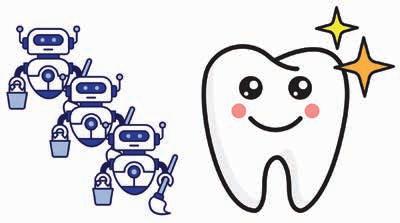

In February, the federal government announced plans to protect access to in vitro fertilization (IVF) and reduce treatment costs. Approximately one in seven couples trying to have a baby are unable to conceive. Each IVF treatment costs between $12,000 and $25,000 per cycle, and multiple cycles may be needed to achieve a successful pregnancy. These costs are generally not covered by health insurance, making IVF financially inaccessible for many Americans.
Although the announcement did not introduce new legislation, it underscores the importance of family formation as a national public policy. The U.S. fertility rate is at a historic low, declining by 3 percent in 2023 compared to the previous year, after a consistent 2 percent annual reduction from 2014 to 2020.
A recent study published in the journal Ecological Solutions and Evidence proposes the reintroduction of gray wolves in Scotland to enhance carbon dioxide (CO2) sequestration. Wolves had been hunted in Scotland since 1238 and were eradicated from the country about 250 years ago. Without wolves, the Scottish red deer population surged to 400,000—about one deer for every 14 people in the country. Consequently, the deer and, in certain areas, sheep hinder the growth of native woodland by eating tree saplings across the region.
According to the study, controlling the deer population with wolves could lead to woodland expansion that would absorb up to 1 million metric tons of CO2 each year, which is approximately 5 percent of the carbon removal target for United Kingdom woodlands. The researchers estimated that each wolf would save almost $200,000 per year in carbon removal costs. This study demonstrates the interconnectedness of climate and biodiversity crises, underscoring the need for integrated approaches to management.

Russian scientists excavated a fragment of 24,000-year-old Siberian permafrost that had remained frozen since at least the end of the Pleistocene epoch. After gradually thawing the permafrost, they noticed microscopic wheel animals known as bdelloid rotifers, which resumed their lives and reproduction. The organisms had been in a long-term cryptobiotic state, where they suspended their metabolism and accumulated certain compounds that facilitated their recovery when conditions improved.
In other studies, frozen organisms, including moss, weeds and tiny worms called nematode, have been brought back to life after at least 1,000 years. The Russian researchers are part of a broader study exploring the existence of living organisms at extremely low temperatures. In the future, plants with cryptobiotic properties could revolutionize various aspects of human life such as farming and storage, or perhaps even assist humans on Mars.
Most hummingbirds are territorial, aggressively challenging competitors over flowers or mates. An ornithologist and birding guide in the Andes Mountains of Ecuador discovered a cave containing 23 adult hummingbirds and four chicks of the Chimborazo hillstar subspecies. After a search of the region, they found six additional colonies. This was the first time hummingbirds had been observed living together, a unique finding published in the journal Ornithology.
These hummingbirds live more than 12,000 feet above sea level on a sparsely vegetated slope, where finding nectar-rich flowers, water and shelter in freezing temperatures and biting winds is challenging. The researchers believe that the harsh environment has led the birds to aggregate for survival. Further research is needed to determine whether the hummingbirds are merely tolerating each other or actively cooperating.


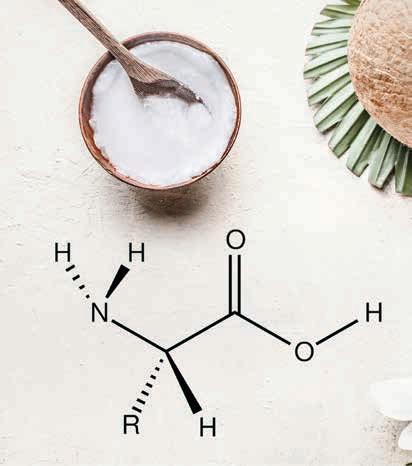
University of Missouri researchers have developed an innovative, eco-friendly chemical tool that could reduce the cost of producing medicines and support the development of clean energy technologies, particularly those aimed at eliminating per- and polyfluoroalkyls, commonly known as “forever-chemicals”, from water sources. Their discovery, published in Angewandte Chemie, a journal of the German Chemical Society, uses a novel electrochemistry approach to build new molecules by using tiny molecular structures derived from naturally occurring amino acids and coconut oil.
The innovative approach replaces hazardous solvents with a non-toxic alternative, thereby mitigating the environmental impact of conventional chemical processes and offering sustainable solutions for the production and storage of clean energy. This advancement could help improve the development of medicines and may be used to treat hyperproliferative, inflammatory and immunoregulatory diseases.
• Improve texture, tone, laxity, redness, browns & luminosity
• Effectively treat: rosacea, prominent vessels, acne, and scars
• Wave goodbye to jiggly arms and saggy skin
• Come out of hiding with cellulite reduction
• Wasting time and money shaving daily? Save with painless laser hair removal
• Legs dragging? Leg vein treatments with minimal downtime or discomfort
• Feel strong again. Non-invasive or surgical body sculpting with sexy results


To love oneself is the beginning of a lifelong romance. — Oscar Wilde
• Post-covid, semiglutide & hormonal hair loss got you down? Revive your natural hair follicles.
• Improve your body composition scientifically, more muscle & less fat.
• Laser assisted liposculpture with or without autologous natural fat transfer to face and body
• Natural fillers derived from your own blood with minimal processing
• Get your juicy back & beat the bedroom blues. Painless non-invasive solutions.
Deborah A. DeMarta, MD, FACS, FAARFM
Cleveland Clinic Trained l You deserve truly qualified and certified care!










A study published in Science suggests that the intricate songs of humpback whales share structural patterns with human language, potentially making them easier for whales to learn. An international team of scientists discovered that humpback whale songs can spread rapidly from one population to another, adhering to Zipf’s Law, which states that the frequency of any word is inversely proportional to its position in the frequency table. For example, in English, the most common word, “the”, is used approximately twice as frequently as the second most common word, “of”, and three times as frequently as the third most common word, “and”. Research suggests that this kind of skewed word distribution can simplify language learning.
Male humpback whales sing lengthy, elaborate songs composed of a variety of sounds strung together in repeated phrases and themes. Male whales in a specific group sing the same song. Scientists recorded eight years of humpback whale songs and categorized them into basic sound elements, including various types of squeaks, grunts, whistles, groans and moans. Subsequently, they identified subsequences of sounds that they believed resembled words. The frequency of these sequences adhered to Zipf’s Law.
For environmentally conscious home dwellers, composting food scraps and yard waste in a pile, bin or specialized tumbler offers numerous benefits. The process involves creating optimal conditions for microorganisms to decompose organic material, transforming it into a valuable soil additive. Composting significantly reduces waste destined for landfills, minimizing methane emissions.
Whether integrated into gardens or potted plants, compost can enhance vegetable harvests and flower blooms, discourage weed growth, improve moisture retention and reduce the reliance on synthetic fertilizers. There are several ways to engage in composting, including indoor or outdoor composting at home, as well as the collection of food scraps for processing at local composting facilities, farms or community gardens.
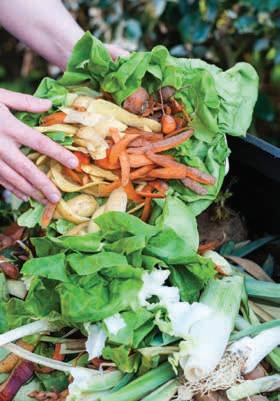
• Build a base with straw or twigs to allow for air flow.
• Alternate layers of green materials (produce scraps, coffee grounds and eggshells) with brown materials (dry leaves or shredded paper), aiming for a three-to-one ratio of browns to greens by volume.
• Maintain the compost slightly damp for moisture balance.
• Turn the compost periodically for aeration.
• Avoid composting meat, fish, dairy products, fats, oils, diseased plants or pet waste.
For those residing in apartments or homes without yards, indoor composting is a good option. It requires an investment in a composter or food recycler that dries and grinds food waste into grounds, and is typically equipped with a filter to eliminate odors. These devices process the waste within three to 12 hours, depending upon
the brand, and are compact enough to fit in most kitchens.
Popular brands like Lomi and Vitamix create fertilizer from food waste, while Reencle adds microorganisms to the composting process. Unlike outdoor composting, these devices make it possible to recycle meat and dairy products. However, read the instructions carefully to ensure that only recommended food waste items are placed in the machines to avoid damaging them.
Whether food scraps are collected for indoor, outdoor or thirdparty composting, a collection bin conveniently placed under the kitchen sink or on the counter makes recycling food scraps a part of the daily cooking routine. Here are some helpful tips:
• Bin Size: Choose a bin large enough to accommodate three to four days’ worth of kitchen scraps for the household.
• Odor Control: Make sure the bin comes with a charcoal filter and/or perforated lid to reduce naturally occurring odors.
• Materials: Opt for eco-friendly bins made out of long-lasting stainless steel or sustainable bamboo. Plastic bins are also available.
• Cover: Consider hinged, flip-top models for ease of use and convenience.
• Waste Size: Cut everything into small pieces to speed up decomposition.
• Cleaning: Regularly wash the bin to prevent odors, fruit flies and other pests.

Natural Awakenings Magazine!
Make a meaningful impact in your community by becoming the owner of a Natural Awakenings magazine. Empower others with current, valuable insights and resources to enhance their physical, mental, emotional and spiritual well-being.
As a franchise owner, you’ll inspire positive change, provide readers with tools for healthier living and connect local businesses with an audience eager for transformation.
Why Own a Natural Awakenings Magazine?

n Create a Healthier Community: Be the go-to resource for wellness and personal growth in your area.
n Boost Your Income: Take control of your financial future with a proven business model.
n Enjoy a Flexible Lifestyle: Work from home while pursuing a fulfilling, dynamic career.
n A proven business model with low startup costs.
n Comprehensive training and friendly, ongoing support.
n Flexible work schedule with many work-from-home opportunities.
n Access to a network of like-minded franchise owners.
n Financing Options Available.
Join a thriving network of passionate franchise owners reshaping the future of holistic health and wellness.
Call 239-206-2000 for a FREE evaluation of your community’s potential. Learn more or apply today at: Corp.NaturalAwakenings.com
Add Your Community to Where Natural Awakenings Is Now Publishing:
• Atlanta, GA
• Boston, MA
• Broward County, FL
• Bucks/Montgomery Counties, PA
• Central Florida/Greater Orlando, FL
• Central New Jersey
• Charlotte, NC
• Chicago, IL
• Columbia, SC
• Dallas, TX
• Daytona/Volusia/Flagler Counties, FL
• Detroit/Wayne County, MI
• Fairfield & Southern Litchfield Counties, CT
• Gainesville/Ocala/The Villages, FL
• Grand Traverse Region/Northern Michigan
• Greater Ann Arbor, MI
• Greater Lansing, MI
• Greater Oakland, Macomb, Livingston, Genesee, MI
• Gulf Coast, Alabama/Mississippi
• Hartford/Tolland, CT - Coming soon
• Houston, TX
• Hudson County, NJ
• Jacksonville/St. Augustine, FL

• Lancaster/Berks, PA
• Lehigh Valley, PA
• Long Island, NY
• Milwaukee, WI
• Monmouth/Ocean Counties, NJ
• Naples/Fort Myers, FL
• New Haven, CT
• New London/Windham, CT - Coming soon
• New York City, NY
• North Central New Jersey
• North New Jersey
• Northwest Florida
• Palm Beach, FL
• Philadelphia, PA
• Phoenix, AZ
• Pittsburgh, PA
• Rhode Island
• Richmond, VA
• Sarasota, Manatee, Charlotte and DeSoto Counties, FL
• South Central Pennsylvania
• South Jersey, NJ
• Southeast North Carolina
• Space & Treasure Coast, FL
• Tampa, FL
• Tucson, AZ
• Twin Cities, MN
• Westchester/Putnam/Dutchess, NY
• Western Michigan

by Marlaina Donato

Hair loss among women can occur at any age for various reasons. However, 30 million Americans from 40 to 60 years old are affected by the most common form, female pattern hair loss (FPHL) or androgenetic alopecia. While it is considered normal to lose 50 to 100 hairs daily, individuals with FPHL notice excessive shedding of 125 or more, as well as an increasingly wider part, progressive thinning and reduced volume.
Because our society places so much emphasis on beauty and youth, hair loss can significantly impact a woman’s outlook and self-esteem. According to a 2023 study published in Dermatology Practical & Conceptual, people with FPHL are at a high risk of developing chronic stress, anxiety and depression.
Although FPHL is primarily inherited, the contributing causes are highly individual and can include a number of other factors such as thyroid disease, vitamin deficiencies, hormonal imbalances, life transitions (pregnancy, postpartum and menopause), polycystic ovary syndrome, stress, anxiety and the use of chemicalladen haircare products. Because of this complexity, there is no one-size-fits-all solution, but if left untreated, FPHL can lead to permanent hair loss.
While United States Food and Drug Administration-approved over-the-counter topical treatments like minoxidil (generic Rogaine) have shown promising results in promoting hair growth, several side effects, such as facial hair and irregular heartbeat, have been reported by the Mayo Clinic, prompting women to seek alternative options.
To that end, Dr. Mark J. Tager, author of Feed Your Skin Right: Your Personalized Nutrition Plan for Radiant Beauty, offers hope, affirming, “Once the root cause is identified—whether it’s a hormonal imbalance, thyroid dysfunction, chronic stress or a nutrient deficiency—hair regrowth is absolutely possible.”
“Hair is not essential for survival, so when something is off internally, the body prioritizes vital organs, leaving hair follicles undernourished and struggling to stay in the growth phase,” explains Tager. “At its core, hair loss is just the body’s way of asking for balance.”
When it comes to hair-supportive supplements, separating fact from hype can be challenging, but the popular supplement Nutrafol has demonstrated promising results. A 2022 study published in the Journal of Clinical and Aesthetic Dermatology evaluated the effectiveness of Nutrafol on male and female pattern baldness. Of the 51 participating premenopausal women with mild-to-moderate hair loss, 79.5 percent experienced significant improvements after 24 weeks of taking a daily Nutrafol women’s formula that contained amino acids, collagen, herbs and vitamins. Researchers concluded that the nutraceutical was effective in improving visible hair growth, volume, thickness, fullness and coverage with less noticeable hair shedding.
To restore the hair’s glory, Cleveland Clinic dermatologist Dr. Shilpi Khetarpal recommends taking a balanced multivitamin every day. Vitamin C promotes collagen production and can help individuals mitigate stress and the elevated cortisol levels that follow. Excessive cortisol promotes inflammation, which can disrupt cell signaling in hair follicles and cause an imbalance between estrogen and testosterone.

“Adequate levels of ferritin, the body’s stored form of iron, are crucial for healthy hair growth. Without enough iron, hair follicles struggle to stay in the anagen (growth) phase, leading to increased shedding and slow regrowth,” says Tager, adding, “Inositol, a natural sugar found in a number of forms, can help regulate hormone levels, most notably dampening the androgens that lead to hair loss.”
According to Jolene Hart, a certified health coach and author of Eat Pretty, maintaining good gut health and nutrient absorption are essential for achieving healthy hair. She notes that tahini, shellfish, spinach, beans and pastured eggs are excellent iron sources, especially when paired with vitamin C for enhanced absorption.
Hart also champions the importance of protein, asserting, “If your hair is breaking easily, growing slowly or looking thin, check on your intake of protein, the number one dietary must-have for healthy hair, as it’s the building block of keratin protein, which gives structure to each hair shaft.”
For those that are not allergic, Hart recommends nettle tea due to its anti-inflammatory properties and the presence of micronutrients like silica that support strong hair. Nettle tea also has the ability to block dihydrotestosterone (DHT), a hormone that can contribute to hair loss.
A small study published in the peer-reviewed journal Cannabis examined the effects of a topical hemp-oil formulation containing approximately three to four milligrams of cannabidiol and minimal amounts of other cannabinoids on 35 adults with patterned hair loss. Over the course of six months, all of the participants experienced some regrowth. On average, there was a statistically significant 93.5 percent increase in hair density. Notably, no adverse effects were reported during the treatment period.
“The transformation was so profound, I’m signing up again!”
~ Abby, Current student
Step Into the Depths Where Your Unconscious Speaks
FREE Intro: Masterclass & Breathwork Sunday, April 27, 9 – 11:30am
12-Week Dream Mastery Program
Starts Wednesday, May 28, 7:30 – 9:30pm Only 8 spots available!
• Personal mythology mapping
• Transform recurring patterns
• FREE BONUS: 45 min “Structure of the Psyche” recording Register: SoulHealingTribe.com/dreams

Rosemary oil massaged into the scalp is an age-old practice gaining renewed attention for rejuvenating tired hair follicles. Trina Felber, a clean beauty and health specialist and author of Beauty’s Dirty Secret, recommends mixing a few drops of rosemary essential oil with a carrier oil like jojoba or argan oil and massaging it into the scalp. After 30 minutes, the mixture can be rinsed out.
Felber also recommends applying fresh aloe vera gel directly to the scalp and leaving it on for 20 to 30 minutes before rinsing with lukewarm water. Alternatively, castor oil can be applied overnight, as it contains ricinoleic acid, a natural compound that supports hair follicle health and enhances scalp circulation.
Felber cautions, “If you’re still using toxic shampoos, endocrine-disrupting hair products and exposing your scalp to chemicals, you’re working against your body, rather than with it.” Her “dirty” list includes two culprits: parabens, which are preservatives that mimic estrogen in the body, leading to hormone imbalances and hair thinning; and phthalates, often labeled as “fragrance” or “parfum”, which are known endocrine disruptors linked to hormonal imbalances that can contribute to hair loss and even metabolic dysfunction.
Marlaina Donato, an author, painter and composer, can be reached at WildflowersAndWoodSmoke.com.
by Carrie Jackson
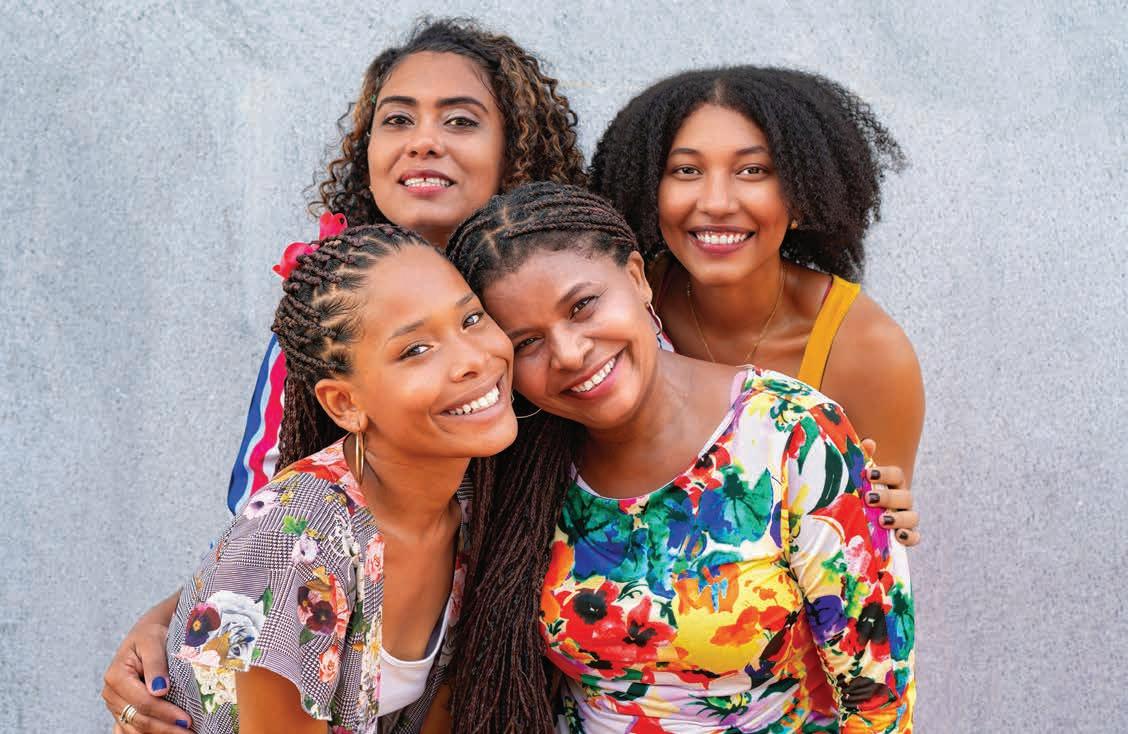
Hormone fluctuations are a natural part of every woman’s life. When balanced, hormones help regulate body functions, transmit vital messages through the bloodstream and provide essential tools during childbearing stages. However, a disruption in this balance can lead to a range of physical, mental and emotional symptoms, causing women to feel overwhelmed and uncentered. Fortunately, lifestyle changes, professional guidance and emotional support can help women achieve
hormonal balance, manage their symptoms and embrace each stage of life with confidence and self-assurance.
Lorraine Maita, a New Jersey-based functional and integrative doctor specializing in bioidentical hormone replacement therapy and founder of The Feel Good Again Institute, categorizes a woman’s hormonal stages
as puberty, postpartum, perimenopause and postmenopause. “Each stage has its own unique characteristics and symptoms that women should be aware of,” she declares. “Because hormones affect mood, weight and energy, women must be prepared to balance their hormones as they ride these waves.”
Hormones surge during puberty and decline during perimenopause, and both phases have similar symptoms. “During these stages, it’s easy to make estrogen, but

not easy to ovulate,” Maita says. “Your body is experiencing estrogen dominance, which can cause a number of symptoms including anxiety, irritability, impatience, insomnia, growth of the breasts, tender breasts, growth of the uterine lining, mood swings, spotting, and heavy, skipped or irregular periods.”
She explains that progesterone is needed to balance the symptoms of estrogen dominance. “Estrogen is the hormone of energy and growth, and progesterone is the hormone of peace and calm. Whether estrogen is high, normal or low, if you don’t have enough progesterone to balance it, you may have some or all of these symptoms.”
In the postpartum stage, hormone levels that were high during pregnancy decrease significantly after giving birth. “A lot of women get postpartum depression after they have a baby,” Maita points out. “Prolactin levels increase while they’re breastfeeding and shift hormone balance, which can leave women feeling drained and anxious. Maternal demands, social isolation and general stress on the body can also contribute to depression.”
In menopause, both estrogen and progesterone levels drop, leading to a permanent cessation of the menstrual cycle and infertility. “Menopause can trigger a number of physical and emotional changes,” Maita remarks. “Women typically feel tired and irritable, gain weight, have trouble sleeping, struggle with poor memory and experience vaginal dryness. Some people can get neurological symptoms such as creepy crawly feelings. The microbiome changes, which can cause gas and bloating. A number of women experience depression and anxiety.”

Although hormonal changes can feel overwhelming, Maita believes that women can regain control by adopting a combination of lifestyle modifications and seeking medical guidance.
“Eating a fiber-rich diet keeps your bowels moving, flushes out toxins and helps to remove excess estrogen,” she explains. “If you’re not moving your bowels, you’re sitting on toxic waste that will get reabsorbed into the system. I recommend loading up on cruciferous vegetables like broccoli, kale, radishes and Brussels sprouts.”
Lorraine Maita, a New Jersey-based functional and integrative doctor specializing in bioidentical hormone replacement therapy and founder of The Feel Good Again Institute, categorizes a woman’s hormonal stages as puberty, postpartum, perimenopause and postmenopause.
“Each stage has its own unique characteristics and symptoms that women should be aware of,” she declares. “Because hormones affect mood, weight and energy, women must be prepared to balance their hormones as they ride these waves.”
Maita advises against exposure to pesticides, plastics and other chemicals in personal care and cleaning products, noting that these toxic substances mimic estrogen and exacerbate hormone swings. Cleaner alternatives can be found by visiting the Environmental Working Group’s Skin Deep database at EWG.org/skindeep
Supplements can also help to minimize symptoms of hormone imbalance. Maita emphasizes that while lifestyle modifications
should be prioritized, she will incorporate herbs into a patient’s treatment plan. “Chaste berry aids with ovulation in younger people, and black cohosh can help with hot flashes and mood. Magnesium is beneficial at any stage. It’s relaxing, can relieve muscle tension and headaches, and calms the nervous system. Melatonin is a very good antioxidant that can help with sleep, which is extremely important. Setting a soothing bedtime routine with lower light, while avoiding food and vigorous exercise, will help the body’s natural circadian rhythm,” she says.
Addressing symptoms before they become troublesome can significantly enhance women’s overall well-being. As explained by Anna Cabeca, a Dallas-based, triple-board-certified obstetrician-gynecologist, “Hormone imbalance can happen at any point, and we don’t want to wait for symptoms to cause unnecessary discomfort. Decreasing inflammation, improving insulin sensitivity and supporting healthy detoxification on a regular basis can set us up to better manage changes when they do occur.”
Stress, environmental factors and ovarian decline can contribute to hormone imbalances. Cabeca advises that managing cortisol levels by increasing oxytocin is a crucial starting point. “If you’re just addressing the reproductive hormones and not looking higher up, you


have a problem,” she says. “In the hierarchy of hormones, oxytocin is the most powerful. It’s a regenerative hormone that alkalizes the body, where cortisol is acidifying. Oxytocin is the hormone of longevity and has been shown to improve the immune system and increase muscle cell regeneration.”
Increasing oxytocin is more potent and effective than decreasing cortisol. Cabeca recommends a shift in perspective toward positivity rather than negativity, saying, “I encourage patients to do things that give them a spiritual lift and reflect on what playtime looks like for them. Getting out in nature, laughing, kissing, positive touch, playing with pets and spending time with good company and community can all boost oxytocin and produce those feel-good chemicals.”
While physical fluctuations may be the most noticeable, hormonal changes can also impact a woman’s mental and emotional well-being. According to Amy Wasserman, a psychiatric advanced practice nurse at Flourish Counseling & Wellness, in Chicago, “Variability in hormones plays a role in the synthesis of neurotransmitters like serotonin, dopamine and GABA [gamma-aminobutyric acid]. So, when there are hormonal fluctuations, we are more likely to experience cognitive effects, which can manifest with various symptoms, including increased anxiety, sleep disturbances, panic attacks, irritability, sensitivity, depressed mood, low self-esteem, intrusive thinking and even suicidal ideation.”
Observing symptoms is a crucial first step to reducing their impact. Wasserman suggests journaling about patterns of physical and cognitive effects to enhance awareness of specific triggers. “Ask yourself, ‘What are the lifestyle or behavioral things I can modify to improve how I am feeling? What are techniques that have worked in the past?’” she proposes. “Physical movement, stretching and weight-bearing exercises are all essential for managing symptoms, particularly during the midlife transition when
estrogen levels decline. Self-care is not just an option, but a necessity to ensure balanced mental health.”
Women can also find support and a sense of community by reaching out to others, which can often be free or low-cost. The Menopause Society recommends that employers provide support to perimenopausal women by providing more flexible work hours and forming affinity groups to foster more open communication among colleagues. “Support groups can provide a sense of normalcy and validation,” says Wasserman. “Participants often feel more hopeful about the future as they hear stories of resilience, receive positive feedback and learn first-hand about various treatment options. The International Association for Premenstrual Disorders offers free support groups, and Postpartum Support International offers more than 50 free virtual support groups throughout the month.”
There is no shame in asking for professional help to manage disruptive mental health symptoms. “Therapy has been proven to be as effective as medication for treating many mental health conditions. Cognitive behavioral therapy, interpersonal therapy, and acceptance and commitment therapy can all help manage symptoms during reproductive changes. Depending on the individual’s history and the nature of their symptoms, eye movement desensitization and reprocessing, dialectical behavioral therapy, and exposure and response prevention may also be beneficial,” Wasserman says.
Prioritizing sleep and embracing acceptance can also help ease hormonal transitions. “Restful sleep can significantly enhance mood and allow a woman to cope with changes she may feel she has little control over,” says Wasserman. “I encourage patients to practice mindfulness to acknowledge and accept the physical and cognitive changes, surrender to things out of their control and try to welcome peace and self-kindness with messages such as, ‘I meet this moment with grace’ or ‘I choose peace over perfection.’”
Maita notes that mindfulness and gratitude can help shift our overall well-being. “Gratitude has very powerful effects on calming the nervous system, which can help your immune and hormone systems. I love a technique called HeartMath, which is deep belly breathing while focusing on your heart and on someone, a place or something that you are deeply grateful for. We want to be in a calm state to weather these storms,” she advises.
Cabeca proposes that these life transitions are natural and serve as catalysts for spiritual growth and renewed purpose. “Instead of menopause, the Japanese use the term konenki, which translates to ‘second spring’. It’s a rebirth, not a disease,” she says. “We are energetic bodies, and that energy is best celebrated with grace and humor.”
Carrie Jackson is a Chicago-based freelance writer and frequent contributor to Natural Awakenings. Connect at CarrieJacksonWrites.com.
Carrie Jackson
With busy schedules and demands for their time coming from every direction, women often struggle to prioritize their own well-being. Anna Cabeca, a triple-board-certified obstetrician-gynecologist, says that dedicating just 10 minutes in the morning for self-care and gratitude can shift our physiology for the entire day. Here are her top recommendations.
Gratitude, laughter and love are three quick ways to get an oxytocin dose in the morning. Before getting out of bed, identify something you are grateful for, somewhere you saw love the day before and something that made you laugh.

Hydration is crucial for overall well-being. Keep a glass bottle of water by the bed. Additionally, begin each day with an alkalizing beverage such as mineral water or juices containing citric acid like lemon, lime and orange to reduce acidity and inflammation.

Movement can diminish stress and help you find balance and positivity. Get outside and do an activity you enjoy like walking, stretching or dancing, even for a few minutes.

by Maya Whitman
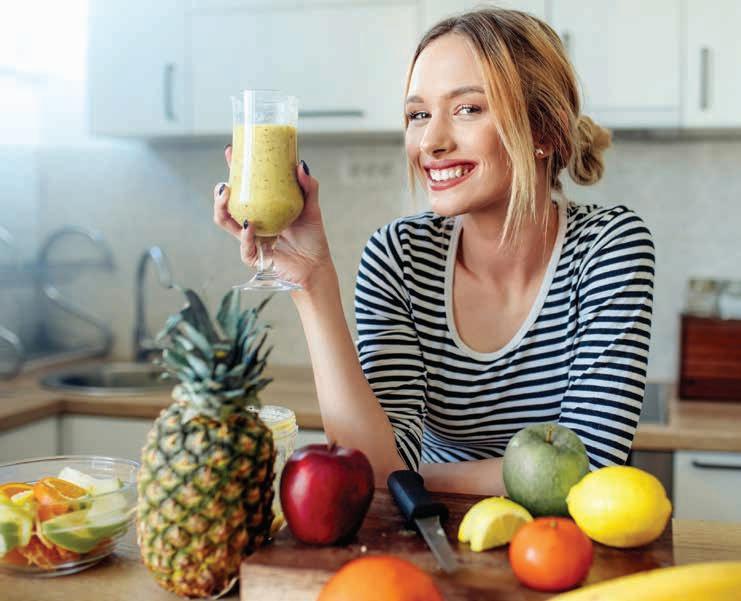
We have all experienced that irresistible craving for a crunchy, salty or sweet snack, propelling us to grab a bag of chips or dip into the cookie jar. While these treats might temporarily lift our mood and energy, they can wreak havoc on our hormones. Ultra-processed food (UPF) has gained significant attention for hormonal disruptions, especially in women. A study published last year in Frontiers in Nutrition noted that adolescent girls were also particularly susceptible to hormonal imbalances when their diet was high in UPF.
Snack favorites such as potato chips or cupcakes are not the only culprits. A 2021 French study published in the Journal of Nutrition reported that UPF accounted for 37 percent or more of the energy intake for vegetarians and vegans, mainly due to meat and dairy substitutes. Individuals transitioning to a non-meat diet tended to consume more ultra-processed meat substitutes and packaged foods compared to those that had long been vegetarian or vegan. Interestingly, the study also determined that non-meat eaters tended to consume more unprocessed foods and fewer fatty and sweet foods.
It is never too early or too late to make small, daily changes that can positively impact our well-being. “The real magic happens when we choose nourishment over numbness, when we eat in a way that sustains us, not just in the moment, but in the long run,” says Laura Peischl, a menopause health coach and hormone specialist with certifications in functional medicine and integrative nutrition.
Understanding the reasons behind our cravings can empower us to make healthier choices for our bodies. “Cravings for salty foods can signal cortisol imbalances, adrenal fatigue or mineral deficiencies,” explains Holly DeLong, a registered dietitian nutritionist specializing in functional medicine and founder of Food & Mood. “Cravings for sweets can stem from blood sugar imbalances, high cortisol levels and even low serotonin, our feel-good neurotransmitter. Cravings for crunchy foods can be associated with repressed anger, iron deficiency or insufficient fiber in the diet.”
Hormonal imbalances can have far-reaching effects beyond estrogen and progesterone. Mindy Pelz, a women’s health specialist and the author of Eat Like a Girl, sheds light on the bigger picture. “If your adrenals become burned out from constantly making cortisol, your body will also have trouble regulating estrogen and progesterone. That affects your sleep cycle and messes with melatonin, which changes your hunger levels through ghrelin and leptin. Basically, a single hormone imbalance can start a chain reaction that ends up sabotaging your overall well-being.”
Peischl, the author of Feel Good Menopause: The Essential Guide to Nutrition and Wellness, as well as the facilitator of a menopause support group on Facebook, reminds us that eating carb-heavy snacks without protein or fat can cause blood sugar spikes leading to a surge in insulin and cortisol, followed by a crash that leaves us feeling tired, irritable and craving more sugar. In times of stress, the synergy of protein, fiber and healthy fat is important for maintaining systemic balance. Opt for an unsweetened yogurt parfait
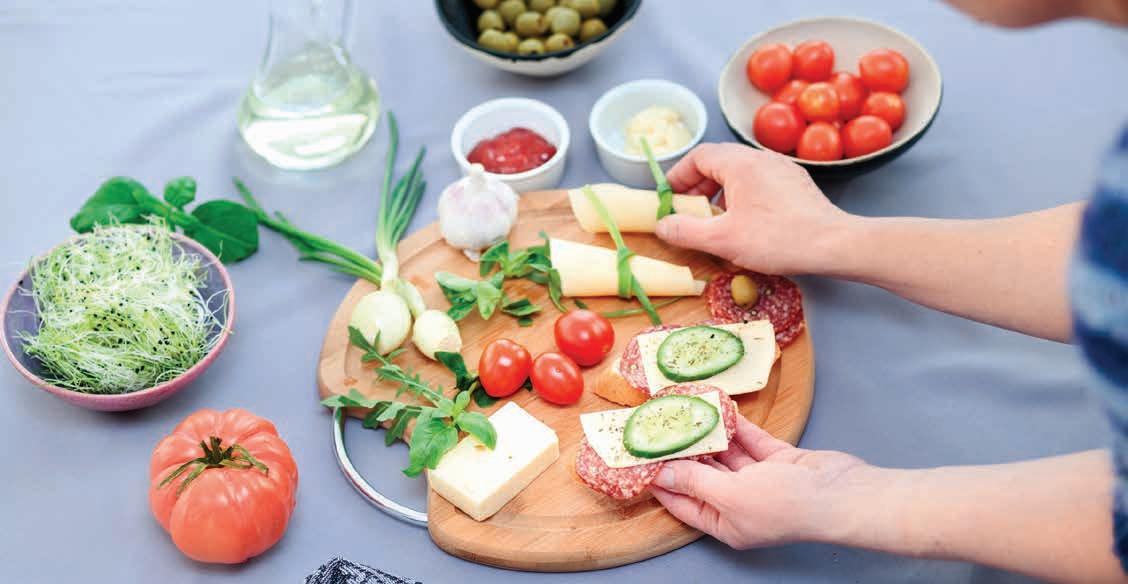
topped with cacao nibs and berries, or an easy-to-make almond butter energy ball as mindful and delicious choices.
For women challenged by infertility, irregular periods, premenstrual syndrome and post birth control syndrome, seed cycling is a growing trend that involves consuming flax and pumpkin seeds during the first half of the menstrual cycle and sunflower and sesame seeds during the second half to promote a healthy balance of estrogen and progesterone levels. These seeds are rich in essential fatty acids and dietary zinc. Additional research is needed to substantiate the efficacy of this practice.
Healthy proteins found in lean meats, organic soy, whey, unsalted nuts, nut butters, quinoa and nutritional yeast support a healthy gut microbiome, which plays a vital role in balanced hormones, insulin regulation and satiety. “Having protein alongside carbs also slows your absorption of carbohydrates, preventing craving-inducing blood sugar spikes,” explains Pelz. She also notes that protein contains the raw materials to build essential hormones, including tryptophan and tyrosine, the latter being a direct
precursor to thyroid hormones. Pelz recommends grass-fed beef, wild salmon, tofu and quinoa as her preferred protein sources.
The sugar habit can incite higher insulin levels, causing insulin resistance, which increases the risk of polycystic ovary syndrome, Type 2 diabetes and fatty liver disease. To overcome a sweet tooth, Pelz suggests taking a two-week sugar sabbatical (including maple syrup and honey) and replacing it with monk fruit, stevia or erythritol. For sweet treats, she prefers fiber-rich apples, kiwis and oranges.
According to Peischl, nuts, seeds, Greek yogurt and avocados can stabilize blood sugar and support neurotransmitter production. Sweet potatoes and lentils offer high-quality, complex carbohydrates and fiber. Noting that the liver plays a crucial role in processing and detoxifying excess hormones, she recommends a small smoothie with berries, flaxseeds and a teaspoon of spirulina for liver support.
DeLong proposes snacking on blood sugar-friendly chia seed pudding with berries, apples with yogurt and peanut butter dip, veggies and hummus, or whole grain
crackers with guacamole. She also advises controlling portions. “Taking your time when eating anything and staying present and mindful can help prevent snacks from turning into meals,” she counsels.
Maya Whitman is a regular contributor to Natural Awakenings.


Chia Protein Bars
YIELD: 12 BARS
1½ cup pitted dates, packed
½ cup almond butter
1 tsp vanilla extract
¼ tsp kosher salt
1 cup raw walnut pieces
½ cup chia seeds
½ cup hemp seeds
½ cup unsweetened, shredded coconut
½ cup non-dairy dark chocolate, chopped
⅓ cup raw cacao powder
Line a 9-by-9-inch baking pan with parchment paper.
In a food processor, pulse the dates until a thick paste forms. Add the almond butter, vanilla and salt and pulse again until thoroughly combined. Add the walnuts, chia seeds, hemp seeds, coconut, chocolate and cacao powder and pulse until thoroughly incorporated.
Using a spatula, press the mixture evenly into the prepared baking pan and freeze overnight.
Remove the pan from the freezer and cut the mixture into 12 bars. Place the bars in an airtight container and refrigerate for up to a week or freeze for up to three months.
Recipe from Eat Like a Girl courtesy of Dr. Mindy Pelz.

YIELD: 1 SERVING
1 cup low-fat Greek yogurt
2 Tbsp chia seeds
1 tsp vanilla extract
¼ cup pumpkin puree
1 Tbsp chopped pecans
In a bowl, combine the Greek yogurt, chia seeds and vanilla extract. Cover with a lid and refrigerate for at least two hours or overnight.
In a glass, layer the ingredients, starting with ½ cup of chia pudding, followed by ⅛ cup of pumpkin puree, ¼ cup chia pudding, ⅛ cup of pumpkin puree and ¼ cup of chia pudding. Top with chopped pecans.
Recipe courtesy of Holly DeLong.
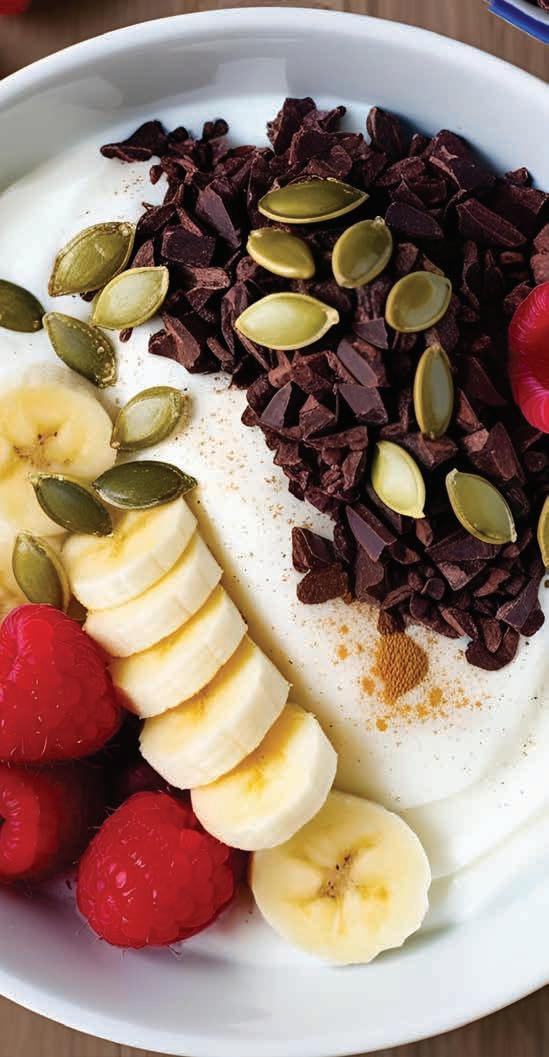
YIELD: 1 SERVING
¾ cup whole-milk, plain Greek yogurt
3 tsp cacao nibs
¼ tsp cinnamon
½ medium-sized banana, sliced
1 Tbsp pumpkin seeds
½ cup raspberries
Top yogurt with all other ingredients and enjoy.
Recipe courtesy of Holly DeLong.



by Tom Whittle
Workout clothing and activewear are prized for their comfort, stretch, durability, moisture-wicking and quick-drying properties, but these garments also contribute to the growing prevalence of microplastics in our water supply, ecosystems and bodies. One problem is the synthetic nature of gym attire. Fabrics like polyester, nylon, acrylic and spandex are non-biodegradable, fossil fuel-dependent and shed

a significant number of microfibers during manufacturing, wearing and washing. A 2019 study published in Scientific Reports estimated that 640,000 to 1,500,000 microfibers were released during each washing machine cycle, depending on the type of garment.
Small but Pervasive
Microfibers, a common type of microplastic, are tiny plastic particles smaller than five millimeters, while nanoplastics measure from one to 1,000 nanometers. They are released into the environment whenever larger pieces of plastic break down, and they end up virtually everywhere, from the ocean depths to the air we breathe. Once in waterways, these minuscule particles are mistaken for food by aquatic life, harming marine species and ultimately entering the food chain that reaches our plates.
Research has revealed that nano and microplastics (NMPs) infiltrate human tissue, including the lungs, placenta and blood. They also build up in the body. A study published in Environmental Science & Technology estimates that by age 18, individuals have an average of 8,300 microplastic particles in their tissues, and by age 70, this accumulation surpasses 50,000 particles.
An increasing body of research suggests a link between plastic exposure and human health conditions. A review of data published in the International Journal of Molecular Sciences presented evidence that NMPs accumulate first in the gastrointestinal tract and later in other tissues, including the brain. A number of effects have been demonstrated, including alterations to the balance of gut microbiota, intestinal barrier permeability (leaky gut), oxidative stress, inflammation, neurotoxicity and behavioral disturbances. A 2023 study published in Frontiers in Endocrinology reported toxic effects by NMPs on the endocrine system.
In response to the growing concern about

NMPs and microfiber shedding, several activewear and textile brands are pioneering eco-friendly materials that do not compromise on performance. Here are a few examples.
• Organic cotton is breathable, soft and biodegradable. While it may not wick away perspiration as effectively as polyester, advancements in cotton blends have enhanced their suitability for active lifestyles.
• Lyocell, derived from sustainably harvested hardwood pulp, is a soft, hypoallergenic, lightweight, breathable, moisture-wicking and biodegradable semi-synthetic fiber used in a number of different textiles.
• Recycled polyester uses post-consumer plastics like water bottles to create fabrics. Although it still sheds microplastics, this option reduces virgin plastic production.
• Bamboo fabric is naturally antibacterial, moisture-wicking and biodegradable. Look for manufacturers that follow sustainable production practices.
• Merino wool offers breathability, temperature regulation and odor resistance, making it an excellent natural alternative for workout gear.
When laundering synthetic activewear, follow these simple steps to reduce microplastic release.
• Wash less frequently. Instead of washing sweaty clothes after every workout, allow them to air-dry and reuse them once in a while.
• Wash on low heat. High temperatures weaken synthetic fibers, causing them to release more microfibers. Opt for cold- or low-temperature washes.
• Use a short, gentle cycle. With less agitation, fabrics tend to remain intact, reducing microfiber shedding and extending the life of the garment.
• Skip the tumble dryer. Hanging clothes to air-dry will significantly reduce fiber shedding.
• Place synthetic garments in a microfiber filter bag. During the laundry cycle, these bags will capture microfibers, preventing them from washing down the drain.
• Install a microfiber filter for the washing machine. This will eliminate the need to presort the laundry, while stopping microfibers from flowing out with the water.
• Use a microfiber laundry ball: These innovative laundry balls will reduce the number of loosened microfibers entering waterways.
Our bodies deserve health; our planet deserves care; and our communities deserve to thrive. When shopping and caring for activewear, consider its impact beyond the gym.
Tom Whittle is the national publishing manager of Natural Awakenings magazine.

by Marlaina Donato
Connections between women and the Earth’s natural rhythms ran deep in ancient civilizations and spiritual traditions worldwide. Women held important roles in agriculture, cultivating the soil and grinding grain. From the village herbalist that brewed roots for ailing townspeople to the Victorian ladies that used floriography (the language of flowers) to convey unspoken sentiments, women’s intimate connection with nature spans millennia. These cultural threads continue to influence our folklore and fairy tales, as well as our reverence for Mother Nature.
When environmental activist Julia “Butterfly” Hill climbed an ancient redwood tree in 1997 to protest the clear-cutting of old-growth forests, she had no intention of living in the forest canopy for two years. This harrowing act of activism not only forged a life-altering relationship with the elements and her inner wilderness, but also inspired a global mission to encourage others to care for the planet in small ways.
The rest of us don’t have to live in a tree to contribute to the environment, but we can begin by repairing our estrangement from Mother Earth. Despite efforts to live sustainably, that innate, energetic umbilical cord connecting us to the natural world has been severed for too many of us. We go days and weeks without sunlight on our skin or sand between our toes. Spending time outdoors has become a forgotten necessity, and we are paying the price
for this alienation between Gaia and our physical bodies.
Taking time to walk the dog, plant a patio flower garden, play on the swings with the grandkids or enjoy a morning coffee on the deck are all simple ways to tap into Mother Nature’s restorative benefits. Planning a camping trip, attending a plant identification workshop or taking lunch
breaks outside can have profound effects on our neurotransmitters, hormonal rhythms and morale. Reestablishing this connection enables us to remember our ancient roots, which, in turn, nourishes a brighter tomorrow.
Marlaina Donato, an author, painter and composer can be reached at WildflowersAndWoodSmoke.com.


Add your Event: establish an account on NAPalmBeach.com/calendar. Due Date: the 10th of the month for print; certain restrictions apply. Email NaturalAwakeningsFLA@gmail. com for details on promoting events online and in print using Natural Awakenings' multi-platform approach!
SATURDAY, MAY 10
Lucidelix Community Keditation — 4-8pm. Join us for an intentional evening of conscious connection through our group ketamine and sound meditation. Medical supervision, preparation, and integration coaching included. Boca Raton. Space is limited, contact Lucidelix at 954-501-0671 for a free Discovery Call. Lucidelix.net
FRIDAY, MAY 16
Special Event in NYC — 6-9pm, $60. Join renowned FUN™ Therapist and author Dr. Kathy Shafer for a transformative experience. The Balance Arts Center, 151 W 30th St., 3rd Fl, New York, NY 10001. Register with Dr. Kathy at 561-799-6789 or Kathy@ DrShafer.org
SATURDAY, MAY 17
Special Event in NYC — 11am-12pm $40. Join renowned FUN™ Therapist and author Dr. Kathy Shafer for a transformative experience. The Balance Arts Center, 151 W 30th St., 3rd Fl, New York, NY 10001. Register with Dr. Kathy at 561-799-6789 or Kathy@DrShafer.org
WEDNESDAY, MAY 28
12-Week Dream and Personal Myth Program for Healing and Growth — “The transformation was so profound, I’m signing up again!” – Abby, Current Student. 12-Week Dream Mastery Program every Wednesday for 12 weeks. 7:30-9:30pm. Only 8 spots available! – Discover your Personal mythology story - Transform recurring patterns. To learn more or register: SoulHealingTribe.com/dream-program.
SATURDAY, JUNE 14
7-Day Heal Your Life® Workshop Leader Training Certification — June 14-20. In Louise Hay’s philosophy. Lead up to 15 different workshops. Patricia Crane, 760-5392227. Training, Orlando. For complete information: https://HealYourLifeTraining.com/ florida-2025
Highlight Your Ongoing Event Here! — Our readers attend published health and wellness events. Order using our online system at NAPalmBeach.com. Due date for ordering is the 10th of the month for the following month’s publication.
Monday
Gentle Yoga at Arcana Yoga — & Fridays 10:30am, $25. Gentle Yoga is unhurried and mindful, allowing students to move slowly and deliberately while focusing on proper alignment and breath awareness. 561-7878036. Register at ArcanaYogaStudio.com/ schedule/
Saturday
Create Powerful Crystal Grids — 9-11am. $40 deposit for Crystal Grid materials. Manifest your intentions. Selection/arrangement of crystals guided by Rena Joy. Soothe Your Soul, 827 Donald Ross Rd, Juno Beach. Limited registrations 561-650-2226. facebook.com/sootheyoursouljunobeach
Simplify finances, amplify impact! – Expert bookkeeping for holistic businesses. Contact Christine, Intention Enterprises: 561-571-1122 Info@IntentionEnterprises.com
Room Available for Rent – in a beautiful healing center in Delray Beach. Call 561-498-1414.
Place your ad here – Natural Awakenings Magazine gets real results. Reach our readers (for the print issue and the online digital issue). Call 561-626-5584 for more information or order online: NAPalmBeach.com/ pages/classified.



Easy ordering online – NAPalmBeach. com/pages/classified. Due date — 10th of the month for the following month’s issue.
GARDENS WHOLISTIC HEALTH CENTER
Dr. Bill Rice, DC, LAc, DCBCN 4360 Northlake Blvd., 2nd Floor Palm Beach Gardens, 33410
561-439-6644
Healthy-Answers.com

Experience Feeling Great!
Dr. Rice – a wholistic physician serving patients since 1977 using Acupuncture, Kinesiology, Gentle Chiropractic care and Nutritional Counseling. We Listen • We Care • We Get Results.
THE HEALING CENTER FOR ALTERNATIVE MEDICINE
16244 S. Military Trail, Suite 120 Delray Beach FL 33484
561-498-1414
DoctorEsther49@gmail.com Elishea.com

Dr. Esther Elisha, AP is a Hadassah Medical School graduate MD practicing alternative medicine.
• Acupuncture • Homeopathy • Holistic Therapy
• Tailored Wellness Programs • Pain Management • General Health Enhancement
We accept all major insurance companies. Call to see if yours covers acupuncture!
CHERIE BENDER, FINE & COMMISSIONED ART STUDIO
561-789-1648
CherieBender.com

Bring joy to your office and home through positive and inspirational art. Please call to make your vision a reality and speak with artist Cherie.
ONENESS PERFUME
OnenessPerfume.com

Scents of Unity: Perfumes That Onenessly Embrace Our Shared Humanity. Discover a fragrance that harmonizes with your values. Join the Movement.
Think Noble • Feel Noble • Be Noble
Scan the display ad’s QR code. See ad page 2.
INNER HEALTH CHIROPRACTIC, LLC
Dr. Kristina Jensen, DC, Reiki Master 1000 Linton Blvd., Suite A7 Delray Beach, FL 33444 561-272-0388
InnerHealthChiropractic@hotmail.com IHCChiro.com

Serving South Palm Beach County since 1992. We are committed to providing our patients with healthcare that is effective and affordable in a friendly and family oriented environment.
HOLISTIC WELL-BEING
1200 N Federal Hwy, Boca Raton 561-922-7070
MyHolisticWellBeing.com

Revolutionary hands-on techniques beyond the traditional. Intuitively identifies the root cause, while relieving pain, promoting healing, restoring mobility and boosting your immune system’s natural ability to fight and overcome. Experienced in treatment of chronic pain, headaches, ehlers-danlos, Parkinson’s, and other conditions.
WOODY’S CREW TREE AND LANDSCAPE
561-325-8917
WoodysTreeCrew@gmail.com

Experienced, Licensed and Insured. ISA Certified Arborist Techniques Used. Trees Big or Small We Do Them All!
See ad page 23.
EILEEN YOCHEVED HANDE, BS, MA, LMT
Back in Balance
7025 Beracasa Way, Ste 202C Boca Raton, FL 33433 561-715-6185
BodyMassageAndBeyond.com

Upledger Certified CranioSacral Therapy for All Ages and Alternative Pain Management/Advanced Manual Therapies.
I have developed innovative approaches to Pain Relief through the integration of these Advanced Healing Therapies for the treatment of: Trauma/Anxiety, Stress, Migraines, TMJ, Car Accident Injuries, Sciatica, Neck/ Back Pain, etc. Since 1993. MA14975, MM10999
REVOLUTION DATING
Kelly Leary, M.S.
Miranda Capparelli
5090 PGA Blvd #208, Palm Beach Gardens 561-630-XOXO (9696) 772-932-HERE (4373) RevolutionDating.com

Are you single? Call to meet the Award-Winning Matchmakers, established in 1991. Every client is prescreened in person at their well-established office. Trusted confidentiality is their practice, and love is their language. Reserve your spot in the club and connect today! #LoveMore2024 #TellYourFriends
INTERNATIONAL CENTER FOR DENTAL EXCELLENCE
Yolanda Cintron, DMD 2021 E Commercial Blvd., Ste. 208 Fort Lauderdale FL 33308 954-938-4599 FortLauderdaleDentistry.com

All phases of dentistry for optimum health, holistic, bio-compatible dentistry.
• Sedation dentistry • Removing of toxic metals • Replacing them with biocompatible materials • Laser dentistry for painless surgeries & extractions • Zirconia/ceramic implants • Natural bone augmentation / Plasma Rich Growth Factor • Oral DNA Testing • Add gums to receding gums.
MERNA MATILSKY, M.D., FAARM, AND ABAARM
Boca Center for Healthy Living 2900 N. Military Trail, Suite 245 Boca Raton, FL 33431
561-994-2007
BocaMed.com
Facebook.com/bocaimaginewellness Services Provided by Dr. Matilsky include Integrative Medicine, Age Management Medicine, BioIdentical Hormone Therapy, Healthy Lifestyle Management, and Weight Loss Programs.

GLISTEN ORGANIC SALON
14545 S. Military Trail
Phenix Salon Suites, Suite 102 Delray Beach, FL 33484
561-767-0371
GlistenOrganic@gmail.com
GlistenSalon.com

“Where nature and beauty meet.” A hidden jewel in the heart of Central Delray. Come and relax in the serene, private environment while receiving the finest in organic and conventional services and products. Let our experience and professionalism guide you to Delray’s First and Best Organic Salon. Celebrating 13 years! See ad page 25
HAIR HOLISTIC ECO-FRIENDLY STUDIO
Ibana Villasenor
141 NW 20th St., Ste. B7 Boca Raton FL 33431
561-372-5354
HairHolistic@gmail.com
HairHolistic.com

Hair services & products with a truly holistic approach like scalp-hair detox, and jet rejuvenation. Hair coloring with Henna or eco-friendly dyes, and formaldehydefree keratine.
HEALING HEART
Nancy A. Keller, DVM, CVH, CVA, CVC 222 W. Boynton Beach Blvd. Boynton Beach, FL 33435
561-740-1313
561-740-0819, fax

Integration of Ancient Wisdom and Modern Medicine. Holistic Veterinary Care for our animal friends. See ads on page 8 and 23. By appointment only.


HOMEOPATHY CURE
Dr. Iqbal Nazir, M.S.D.Pharm, D.H.S. Licensed Lab Medicine Practitioner 954-226-3652
HomeopathTreatment.com

Natural Cure in Homeopathy of most diseases and symptoms. No side effects.
Call Doctor Iqbal Nazir, Functional Homeopathic Specialist for an appointment today.
DEBORAH A. DEMARTA, MD, FACS, FAARFM
Institute of Health & Wellness 218 SW Atlanta Ave, Stuart, 34994 772-539-9556
InstituteHealthWellness.com

Anti-Aging, Functional and Regenerative Medicine. Colorectal Surgery and Functional GI, hormone replacement, food allergy and nutritional testing, IV vitamin therapy, heavy metals testing, medical aesthetics, THERMIva vaginal rejuvenation, ThermiSmooth skin tightening, HALO skin resurfacing, BBL BroadBand Light skin therapy, laser hair removal, botox and fillers, skin care, weight loss. See ad page 11.
PREMIER MEDICAL MASSAGE
Michell Robinson 1025 N L St, Lake Worth Beach, 33469 561-900-6743
MarPerkins561@gmail.com
PremierMedicalMassage.com

Expert medical massage therapist specializing in pain relief and improved mobility. Helping those who’ve struggled to find effective solutions reclaim comfort and freedom of movement.
TARA KARRON
561-444-8102, West Palm Beach
TaraKarron@live.com
TaraKarron.com

Tara channels Archangel Michael and your spirit guides to offer clarity and closure using third eye visions and cards.
Video chat or in-person sessions available.
ORACLE OASIS
561-316-9535
Hello@OracleOasis.com OracleOasis.com

Intuitive service combining tarot, oracle cards, and pendulum, empowering you with clarity, perspective, and understanding to shape your future and trust your inner guidance.
THE RAW VEGAN LIFE COACH
561-616-9603, landline
Amy@TheRawVeganLifeCoach.com
TheRawVeganLifeCoach.com

Want better health? Try going raw vegan! Amy’s 3-step transformational course will improve your life, with support and inspiration every step of the way.
